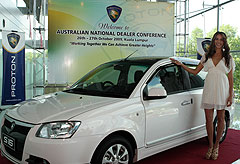Proton to rewind clocks to $10,990
BY MARTON PETTENDY | 18th Dec 2009

Technically, given that dealer delivery and statutory charges amount to much more than $1000, this month’s new S16 sedan – which Proton Cars Australia bills as Australia’s lowest priced sedan – is already cheaper than that.
But while the 1.6-litre S16 GX sedan’s $11,990 driveaway will revert to a list price (plus on-road costs) within a few months, the 1.3-litre S16 G sedan’s sub-$11,000 sticker will be a permanent list price.
GoAuto understands that the last new vehicle to be sold in Australia for $10,990 was Hyundai’s 1991 Excel three-door hatch, which was powered by a 62kW 1.5-litre engine mated to a four-speed manual transmission.
The same year saw Suzuki lift the price of its 1991 Swift three-door, powered by a 39kW 1.0-litre three-cylinder engine, to $11,390 – up from $10,990 in 1990.
While similar money buys a number of larger and more powerful second-hand cars, factor in inflation over the past 20 years and it is possible the S16 is the most affordable new car ever sold in Australia.

Suzuki set the latest round of new-car price cuts in motion in August by launching Australia’s first affordable sub-light-sized model, the Indian-built five-door Alto hatch, at a list price of $12,490 or a driveaway price of $13,990.
The latter is the same as the list price of Hyundai’s three-door Getz 1.4 S hatch and Proton’s own five-door Savvy 1.2 hatch – previously the least expensive new cars available in Australia.
With the expected passenger car onslaught from Chinese brands such as Chery, Great Wall, Geely and Lifan so far failing to materialise – and Korean brand Hyundai continuing to evaluate the local prospects of its Indian-built micro-hatch, the i10 – Malaysia’s national car-maker now appears to be the brand to beat in terms of bargain-basement pricing.
Hyundai has also been the fastest growing mainstream brand in Australia this year, but that’s a title that could also go to Proton next year, if the fledgling small-car brand meets its ambitious sales targets in 2010.
Proton Cars Australia sales were up almost 38 per cent in November, when it sold 146 vehicles – including the first 82 examples of the new S16 to hit Australian roads. The company expects to sell 300 cars in December – up to 250 of which will be S16s – representing a 250 per cent monthly sales increase.
To November, PCA sales are down more than 25 per cent this year, but general manager of sales and operations Billy Falconer says that number will be in line with the industry at 10 to 15 per cent down for 2009, when it expects to sell around 1600 cars – down from about 1850 in 2008.
Next year, however, PCA plans to sell up to 5000 vehicles, thanks to new entry-levels versions of the S16, Gen.2, Persona and Satria (which will also gain performance variants), plus a redesigned Jumbuck ute in the first half and the all-new Exora people-mover in late 2010.
“Admittedly we’re coming off a low base, but we’re setting pretty high goals for next year,” Mr Falconer told GoAuto.
“We’ve sold out (of the S16) of all but two colours and dealers are now ordering off the boat. The order bank is out as far as two or three months,” he said.
The S16 GX light sedan is powered by a 1.597-litre four-cylinder petrol engine that produces 82kW at 6500rpm and comes as standard with a five-speed manual transmission.
Riding on a 2465mm wheelbase, it measures 4257mm long, 1680mm wide and 1502mm high, and has a tare weight of just 1050kg and a gross vehicle mass of 1425kg. Ground clearance is 150mm, while braking is via 236mm front discs and 180mm rear drums.
Standard equipment includes 13x5.0-inch alloy wheels with 175/70-section tyres, a driver’s airbag, air-conditioning, an immobiliser/alarm and central locking, while options include a front passenger airbag, 14x5.5-inch alloys with 185/60 tyres, power windows and mirrors, front foglights and reversing sensors. Neither anti-lock braking system (ABS) nor electronic stability control (ESC) is available.
An automatic version of the S16 GX 1.6 sedan will become available in March priced at $13,990, while in April, the GX will be supplemented by the 1.3-litre S16 G sedan with the same specifications for $10,990 - or $11,990 driveway, ensuring the S16’s current price point continues.
A flagship GXR version of the S16 is due in Australia in July, powered by a 1.6-litre engine and priced at $15,990 ($17,990 auto).
Before then in January, however, Proton will also introduce entry-level ‘G’ versions of the 1.6-litre Satria Neo three-door hatch ($14,490 manual, $16,490 auto), the 1.6-litre Persona sedan ($14,990 manual, $16,990 auto) and Gen.2 five-door hatch ($15,990 manual, $17,990 auto).
While PCA remains mum on the redesigned Jumbuck ute it has committed to releasing here in the first half of 2010, the second half will see Proton release ‘LE’ manual and auto versions of the 1.6-litre Persona (August) and S16 (September), and a top-shelf manual ‘CPS’ version of the Satria Neo in October.
Rounding out a bumper year for Proton here will be the brand’s first people-mover, the seven-seat Exora, which will initially be available from November in GX guise with a turbocharged 1.6-litre petrol engine.
Proton Cars recently hosted more than 80 Australian dealer representatives at its national dealer conference in Malaysia, where dealer principals and sales and operations managers viewed the new Proton model range, plus future products and concepts.
The two-day event also included tours of both Proton’s existing Shah Alam production plant and its new factory at Tanjung Malim, plus inspection of the company’s R&D facility and drives of the S16 and Exora at the Proton test track.
The conference was kicked off by the release of the S16, which was unveiled by Miss Universe Australia 2009 winner Rachael Finch, before an awards presentation to honour PCA’s top-performing dealers.